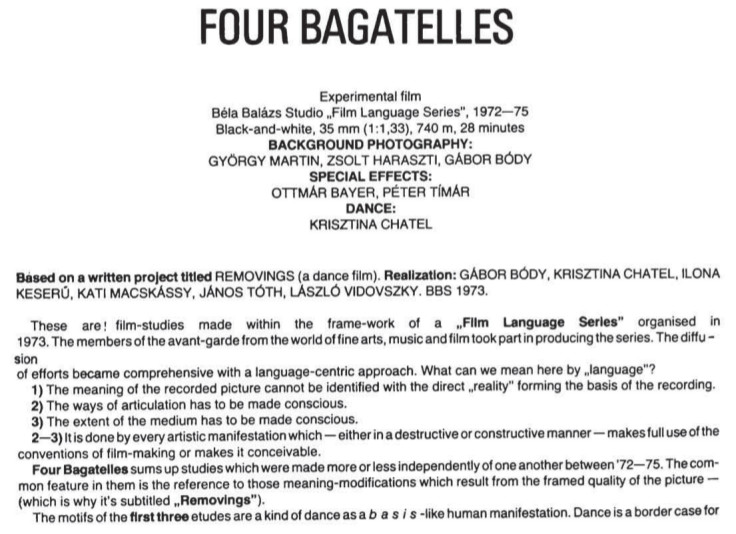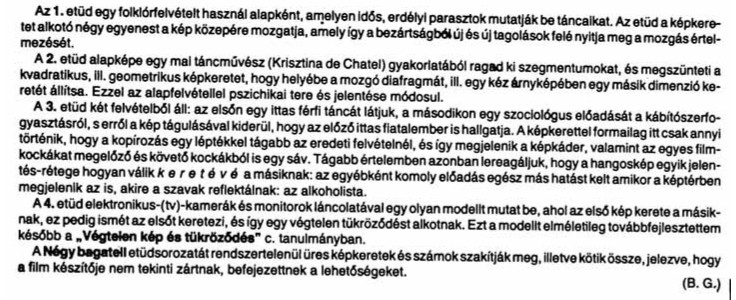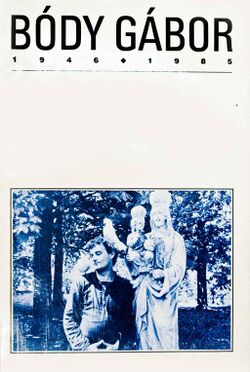Gábor Bódy
 In his film Kutya éji dala [The Dog's Night Song], 1983. | |
| Born |
August 30, 1946 Budapest, Hungary |
|---|---|
| Died |
October 24, 1985 (aged 39) Budapest, Hungary |

Gábor Bódy (1946, Budapest - 1985, Budapest) was a film director, screenwriter, theoretic, and occasional actor. A pioneer of experimental filmmaking and film language, Bódy is one of the most important figures of Hungarian cinema.
Life and work[edit]
Bódy was born in an urban middle-class family. He studied history and philosophy at Loránd Eötvös University and later filmmaking at the Academy for Theater and Film Arts. During his university days he became an influential member of the Béla Balázs Stúdió (BBS). He made his first film A Harmadik (The Third) (a documentary about students preparing an adaptation of Faust on stage) in 1971. He established various experimental and avantgarde projects at BBS including the Film Language Series in 1973 and the K/3 experimental film group in 1976, reshaping the postwar Hungarian avantgarde film's path.
In 1975 he completed his debut feature at BBS, which was also his graduation thesis film at the university. Amerikai Anzix [American Torso] won the Grand Prize for best new filmmaker at "International Filmfestival Mannheim-Heidelberg" and the Hungarian Film Critics prize for best first film. The film which decipts the lives of Hungarian 1848 Revolution veterans in the American Civil War features Bódy's experimentalism at the fullest. The whole film was re-edited using his own method called "light editing" in order to make it resemble a wracked silent film from the late 1800s.
His next feature Narcisz és Psyché [Narcissus and Psyche] was the largest-scale Hungarian production of its era. This epic production based on Sándor Weöres's poetic work Psyché starred Patricia Adriani, Udo Kier and György Cserhalmi and exists in three versions: an original 210-minute two part version, a 136-minute version for foreign distribution and a 270-minute three part television version.
In 1980 Bódy began to work on the first international video magazine INFERMENTAL and managed to publish the first of 10 issues (plus one special issue) while on a residency at DAAD Berliner Küunstlerprogram in 1982. The series published featured a range of guest editors and in total included work from over 1500 artists from 36 countries and was published up to 1991.
After many frustrated projects Bódy managed to complete what was to become his final feature film Kutya éji dala [Dog's Night Song]. Bódy cast himself as the lead in this ambitious and influential feature which incorporated Super8 and video footage as well as a range of Hungarian underground punk bands of the time in order to a film "deeply rooted in the fundamentals of today's reality."
In 1985 Bódy died under sketchy circumstances. A later published information (2001) hints his earlier collaboration (1973-1983) with the Hungarian Secret Police, the III/III. Authorities of the time (Hungary was then considered a 'satellite' country of the Soviet Union) stated that he had killed himself. His widow instead preferred a charge of murder against certain unidentified parties. No official investigation followed and Bódy's fate remains a mystery to this day.
Works[edit]
Négy Bagatell (Four Bagatelles)[edit]
Dir. Gábor Bódy, 35mm, 28 min, 1975. Download (WEBM), Subtitles
Source: László Beke, Miklós Peternák (eds.), Gábor Bódy, 1946-1985: A Presentation of His Work, Budapest: Műcsarnok, 1987, pp 90-91.
De occulta philosophia (Philo-Clip)[edit]
by Gábor Bódy, video, 1983. Download (WEBM).
The confrontation with philosophical and mythical themes—see the formal and experimental, film narration Narcissus und Psyche—was among the central motives in the work by Gabór Bódy. In De occulta philosophia (Philo-Clip), visualizing a secret knowledge concerning the nature of man with direct references to the Renaissance and Leonardo da Vinci, precisely the treatise of Agrippa von Nettesheim of the same name, is reworked to a disassociating geometry. The use of laser beams structures the duration of the tape, which evolved from a collaboration with Llurex (Egon Bunne) at the dffb in Berlin, and was also published in the context of the video magazine Infermental, of which Bódy was one of the founders.[2]
Eurynomé tánca (Dancing Eurynome, Mytho-Clip)[edit]
by Gábor Bódy, video, 1985. Download (WEBM).
Dancing eurynome (Mytho-Clip) is dedicated to the Greek Goddess Eurynome, the child of Oceanus and Tethys. She was the mother of the Graces and of the river-god Aesopus. Eurynome dances on water - and to the music of der Plan. Astrological symbols (an egg, a bird and the suchlike) are added to the image of her mythical dance. In Mytho-Clip (as in Philo-Clip and Lyric-Clip), Bódy exploits video's considerable potential to transform the image.[3]
Walzer (Lyric-Clip)[edit]
by Gábor Bódy, video, 1985. Download (WEBM).
There is also dancing in this tape but this time it's about the lyric dance of youth and is depicted by Bódy in an unconventional way. Walzer is a poem written by Novalis, the German romantic poet (1772-1801) to mark the premature death of his fiancée Sophie von Kühn. The text of Walzer is recited and appears in a spiral - the spiral of life? Lyric-Clip reflects the transience of youth as borne out by the macabre, dancing skeleton that appears on screen.[4]
On Bódy[edit]
Miklós Peternák: Gábor Bódy. The Artist and the Computer[edit]
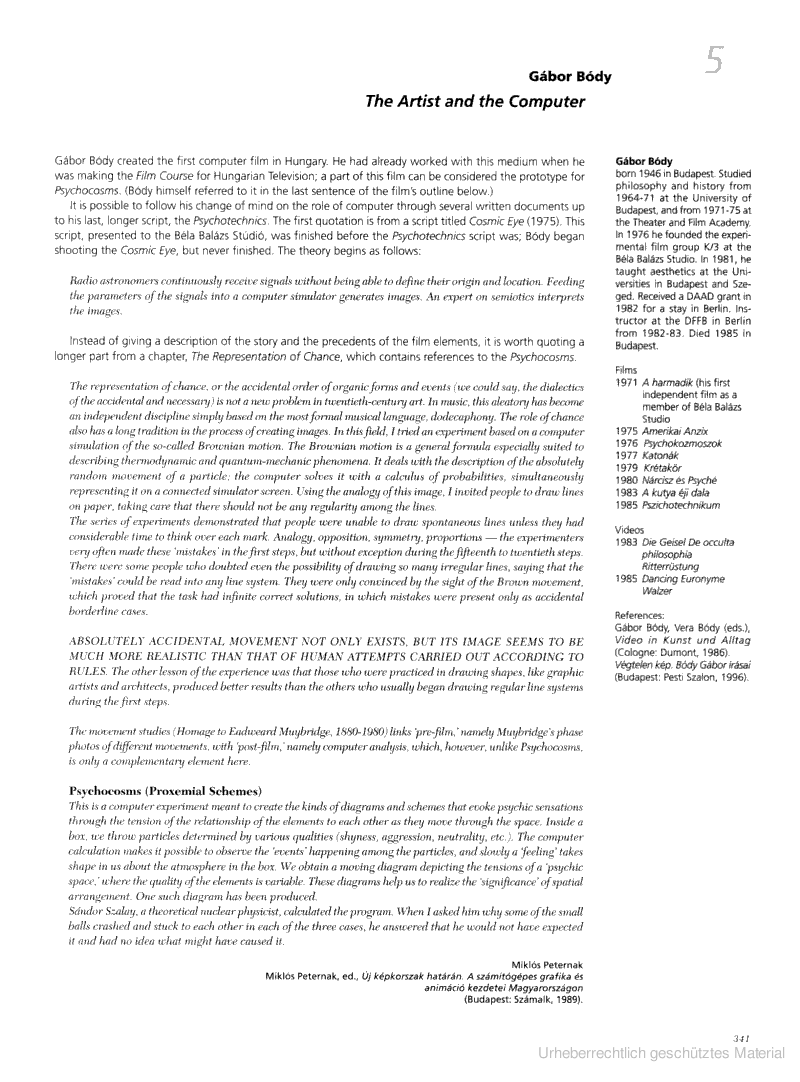
source: Miklós Peternák, "Gábor Bódy. The Artist and the Computer", in Beyond Art. A Third Culture, edited by Peter Weibel, 2005.
Bryan Burns about Gábor Bódy[edit]
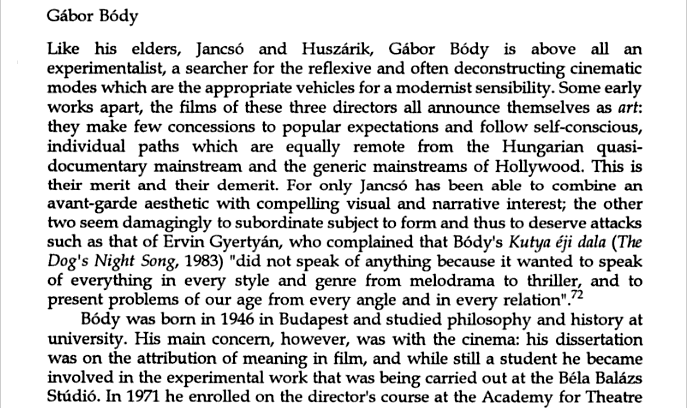
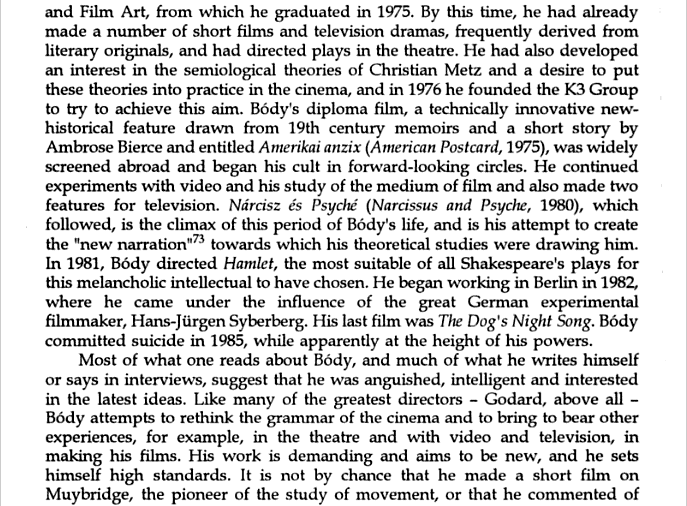
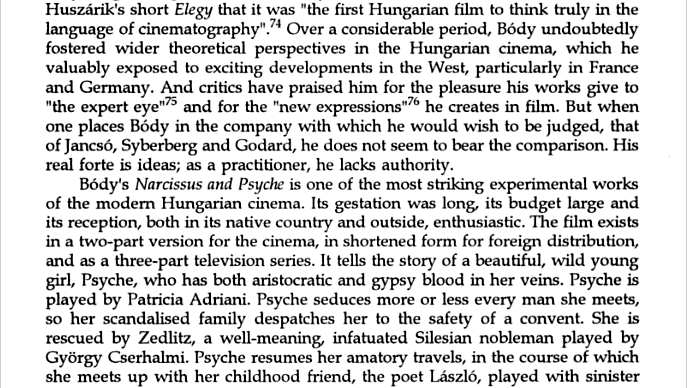
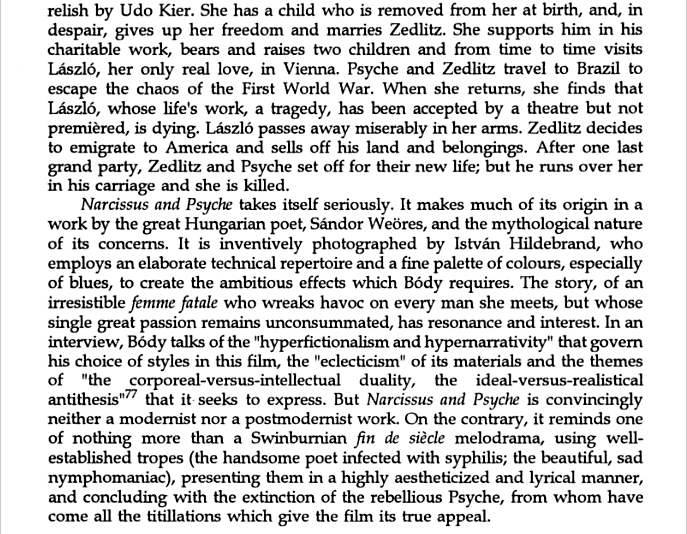
source: Bryan Burns, World cinema: Hungary, 1996, pp 171-173.
Filmography[edit]
- Feature films
- Amerikai Anzix [American Postcard], 35mm, B&W, 104 min, 1975.
- Nárcisz és Psyché [Narcissus and Psyche], 35mm, colour, one-part version 136 min, two-part version 270 min, three-part TV version 270 min, 1980.
- Kutya éji dala [The Dog's Night Song], 35mm, colour, 147 min, 1983.
- TV films
- Filmiskola [Film School], 16mm, B&W, 87 min, 1976.
- Katonák [Soldiers], TV, colour, 90 min, 1977.
- Krétakör [Chalk Circle], TV, colour, 95 min, 1978.
- Hamlet (A fegyveres filozófus) [Hamlet (The Armed Philosopher)], TV, colour, 173 min, 1981-82. A theater performance of Hamlet, recorded by Hungarian state television.
- Short films and videos
- A Harmadik [The Third], 35mm, B&W, 50 min, 1971.
- Fogalmazvány a féltékenységrõl [Draft on Jealousy], 16mm, B&W, 20 min, 1972.
- Ifivezetok [Youth Organisation Leaders], 16mm, B&W, 42 min, 1972.
- Tradicionális Kábítószerünk [Our Traditional Drope], 16mm, B&W, 30 min, 1973.
- Négy bagatell [Four Bagatells], 35mm, B&W, 28 min, 1972-75.
- Hogyan verekedett meg Jappe és do Escobar után a világ [After Jappe and Do Escobar fought how did the world come to fight], 16mm, B&W, 40 min, 1974.
- Pszihokozmoszok [Psychocosmoses], 35mm, B&W, 12 min, 1976.
- with Péter Timár, Privát történelem [Private History], 35mm, B&W, 25 min, 1978.
- Mozgástanulmányok 1880-1980 (Homage to Eadweard Muybridge) [Motion Studies 1880-1980 (Homage to Eadweard Muybridge)], 35mm scope, colour, 18 min, 1980.
- with Marcel Odenbach, Conversation between East and West, video, colour, 3 min, 1982.
- Die Geschwister [Brother and Sister], video, colour, 27 min, 1982.
- Der Dämon in Berlin [The Demon In Berlin], super-8 and video, colour, 28 min, 1982.
- Die Geisel [The Hostage], video, colour, 22 min, 1983.
- De occulta philosophia (Philo-clip), video, colour, 3 min, 1983.
- Rittersrustung [Armour], video, colour, 40 min, 1983.
- Either/Or In Chinatown, video, colour, 37 min, 1984.
- Euronyme tanca (Mytho-clip) [Dancing Eurynome (Mytho-clip)], video, colour, 3 min, 1985.
- Walzer (Lyric-clip), video, colour, 3 min, 1985.
- Collaborations
- Agitátorik [Agitators], dir. Dezsó Magyar, 35mm, 82 min, 1969. (screenplay, actor)
- Aldrin', dir. László Vidovszky, 35mm, 14 min, 1976. (camera)
Publications[edit]
Books, video-books and video-magazines[edit]
- Editor, with Veruschka Bódy, Infermental, video art magazine, 1980-1986.
- Mutante Medien, Video/Book.
- Editor, with Veruschka Bódy, AXIS, Cologne: DuMont Verlag, 1986, 117 min. Video/book. Two-hour cassette anthology of international video art accompanied by an explanatory book.
- Editor, with Véra Bódy, Video in Kunst und Alltag. Vom kommerziellen zum kulturellen Videoclip, Cologne: DuMont Verlag, 1986.
- Zeit-transgraphie, Berlin: Berlin Film Festival, 1986. Brochure.
Articles[edit]
- "Confession on writing and film", Budapest, 1970
- "Ultratraditionalism tratra or the art of frantic fidelity", Budapest, 1974
- "To the debate of the film language series", Budapest, 1974
- "Introduction to the work schedule of group K3", Béla Balász Studio, 1976
- "The Directions of Young Hungarian Film", Valóság, 1977. Paper.
- "Die kreative Sprache der Kinematographie", 1983. Paper.
- "Cosmic eye – science non-fiction (fiction)", Béla Balász Studio, 1975
- "Infinite Image and Reflection. Total Expanded Cinema". A lecture delivered at the Edinburgh Film Festival, 1978
- "Was ist Video – work in progress", Berlin, 1983
- "Das schöne Licht" (in connection with the Light seminar), Berlin, 1983
- "Attribution of meaning in cinematography", Berlin-Budapest, 1983
- "Filme, Video, Video auf Film", Film auf Video, Berlin, 1983
- "Either/Or in Chinatown", Video Guide, Vancouver, 1985
Catalogues[edit]
- Bódy Gábor, 1946-1985: életműbemutató / Gábor Bódy, 1946-1985: A Presentation of His Work, eds. László Beke and Miklós Peternák, Budapest: Műcsarnok, 1987, 335 pp. (Hungarian)/(English)
- Hommage à Bódy Gábor (1946–1985), ed. Vera Baksa-Soós, Budapest: Ludwig Museum, 2006, [41] pp. (Hungarian)/(English)
- Der Stand der Bilder: die Medienpioniere Zbigniew Rybczyński und Gábor Bódy / State of Images: The Media Pioneers Zbigniew Rybczyński and Gábor Bódy, eds. Siegfried Zielinski und Peter Weibel, Nürnberg: Verlag für Moderne Kunst, 2011, 156 pp. Publisher. (German)/(English)
- A képek állása – A médiaművészet úttörői: Zbigniew Rybczyński és Bódy Gábor, Budapest: C3, 2012, 88 pp. (Hungarian)
- Gábor Bódy: Video Works, eds. Éva Kozma und Miklós Peternák, Budapest: C3 Center for Culture & Communication Foundation, 2011, 138 min. DVD. Booklet. [5]
Literature[edit]
- J. Hobermann, "Gabór Bódy", Artforum 19, 1981.
- K. Sierek, N. Ender, Filmlogbuch 2, 1985.
- L. Beke, NIKE – New art in Europa, 1986.
- I. Antal, Muvészet 8, 1987.
- Izabella Füzi, "Where is Reality? Photographic Trace and Infinite Image in Gábor Bódy's Film Theory", Acta Univ. Sapientiae, Film and Media Studies 1, 2009, pp 35-46. (English)
- Dan Kidner, George Clark and James Richards, A Detour Around Infermental, Southend-on-Sea: Focal Point Gallery, 2012.
- "The State of Image. Die Medienpioniere Zbigniew Rybczyński und Gábor Bódy. Interview mit Zbigniew Rybczyński", 2012. (English/Hungarian)
- Kamil Lipiński, "On the re-emergence of motion and innovations in the Gábor Bódy's intermedia experiments", Journal of Aesthetics & Culture 7:1, 2015. (English)
- Sonja Simonyi, "Second looks: archival aesthetics and historical representation in American Postcard (1975)", Studies in Eastern European Cinema 7(1): "Experimental Cinema in State Socialist Eastern Europe", eds. Ksenya Gurshtein and Sonja Simonyi, 2016. [6] (English)
- Friederike Anders, "Zeittransgrafie, Videolabyrinth und Gábor Bódy", transmediale journal 0, 2017. [7] (German)
- "Zeittransgraphie, Videolabyrinth, and Gábor Bódy", transmediale journal 0, 2017. (English)
- Sonja Simonyi, "The Man Behind the Curtain: Gábor Bódy, Experimental Film Culture and Networks of State Control in Late Socialist Hungary", Third Text 153: "Actually Existing Artworlds of Socialism", Jul 2018, pp 519-529. (English)
- Jávorszky Béla Szilárd, "Nagylemezek helyett - A kortárs magyar film és a popzenei underground kapcsolata a nyolcvanas években", Jávorszky Béla Szilárd honlapja, Feb 2019. (Hungarian)
See also[edit]
Links[edit]
- http://bodygabor.hu/
- Biography at bodygabor.hu
- Bódy at Wikipedia
- Biography at MediaArtNet
- http://www.ludwigmuseum.hu/site.php?inc=kiallitas&kiallitasId=291&menuId=10, http://issuu.com/ludwigmuseum/docs/body_gabor
- http://www.cinovid.org/person/2593
- http://newmedia-arts.net/cgi-bin/show-art.asp?LG=GBR&ID=A000000257&na=BODY&pna=GABOR&DOC=expo
- State of Images--The Media Pioneers Zbigniew Rybczyński and Gábor Bódy exhibition,Berlin, Karlsruhe, Budapest and Wroclaw, 2011-2013.
- http://web.archive.org/web/20171114123629/bbsarchiv.hu/en/artist/body-gabor-33

